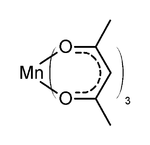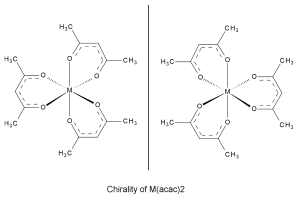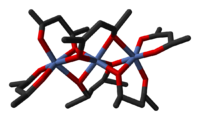- Metal acetylacetonates
-
Metal acetylacetonates are coordination complexes derived from the acetylacetonate anion and metal ions, usually transition metals. The ligand acetylacetonate is often abbreviated acac. Typically both oxygen atoms bind to the metal to form a six-membered chelate ring. The simplest complexes have the formula M(acac)3 and M(acac)2. Mixed-ligand complexes, e.g. VO(acac)2, are also numerous. Variations of acetylacetonate have also been developed with myriad substituents in place of methyl.[1] Many such complexes are soluble in organic solvents, in contrast to the related metal halides. Because of these properties, acac complexes are sometimes used as catalyst precursors and reagents. Applications include their use as NMR "shift reagents" and as catalysts for organic synthesis, and precursors to industrial hydroformylation catalysts. C5H7O2− in some cases also binds to metals through the central carbon atom; this bonding mode is more common for the third-row transition metals such as platinum(II) and iridium(III).
Synthesis
A general method of synthesis is to treat a metal salt with acetylacetone, acacH:[2]
Addition of base assists the removal of a proton from acetylacetone and shifts the equilibrium in favour of the complex. Both oxygen centres bind to the metal to form a six-membered chelate ring. In some cases the chelate effect is so strong that no added base is needed to form the complex. Some complexes are prepared by metathesis using Tlacac.
Classification by metal
Titanium bis(acetylacetonate)dichloride
Treatment of TiCl4 with acetylacetone gives cis-TiCl2(acac)2, a red-coloured, octahedral complex with C2-symmetry:
- TiCl4 + 2 Hacac → TiCl2(acac)2 + 2 HCl
This reaction requires no base. The complex TiCl2(acac)2 is fluxional in solution, the NMR spectrum exhibiting a single methyl resonance at room temperature.[3]
Vanadyl acetylacetonate
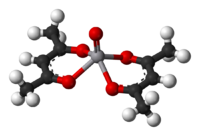 A ball-and-stick model of VO(acac)2
A ball-and-stick model of VO(acac)2
Vanadyl acetylacetonate is a blue complex with the formula V(O)(acac)2. This complex features the vanadyl group, and many related compounds are known. The molecule is square pyramidal, with idealized C2v symmetry. The complex catalyzes epoxidation of allylic alcohols by peroxides.
Chromium(III) acetylacetonate
Cr(acac)3 is a typical octahedral complex containing three acac- ligands. Like most such compounds, it is highly soluble in nonpolar organic solvents. This particular complex, which has a three unpaired electrons, is used as a spin relaxation agent to improve the sensitivity in quantitative Carbon-13 NMR spectroscopy.[4]
Manganese(III) acetylacetonate
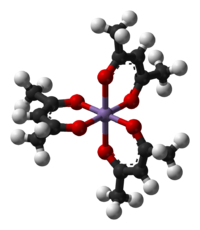 Ball-and-stick model of ∆-Mn(acac)3, with Jahn-Teller tetragonal elongation
Ball-and-stick model of ∆-Mn(acac)3, with Jahn-Teller tetragonal elongation
It is prepared by the direct reaction of acetylacetone and potassium permanganate.[5] In terms of electronic structure, Mn(acac)3 is high spin. Its distorted octahedral structure reflects geometric distortions due to the Jahn-Teller effect. The two most common structures for this complex include one with tetrahedral elongation and one with tetragonal compression. For the elongation, two Mn-O bonds are 2.12 Å while the other four are 1.93 Å. For the compression, two Mn-O bonds are 1.95 and the other four are 2.00 Å. The effects of the tetrahedral elongation are noticeably more significant than the effects of the tetragonal compression.[6]
Mn(acac)3, a one-electron oxidant, is used for coupling phenols.[7]
Iron acetylacetonates
Ferric acetylacetonate, Fe(acac)3, is a red high-spin complex that is highly soluble in organic solvents. It is configurationationally labile, high-spin complex with five unpaired electrons. It is occasionally used as a catalyst precursor.[8] Although configurationationally labile, Fe(acac)3 has been partially resolved.[9] The ferrous complex Fe(acac)2 is oligomeric.
Ruthenium acetylacetonates
Like iron, Ru forms a very stable tris(acetylacetonate). Reduction of this Ru(III) derivative in the presence of other ligands affords mixed ligand complexes, e.g. Ru(acac)2(alkene)2.[10]
Cobalt acetylacetonates
Co(acac)3 is low-spin, diamagnetic complex. Like other compounds of the type M(acac)3, this complex is chiral (has a non-superimposable mirror image). Many such complexes have been resolved, but the premier example is Co(acac)3.[9]
The complex Co(acac)2, like the related nickel complex, exists octahedral complexes with two additional ligands. The anhydrous form exists as the tetramer [Co(acac)2]4. Like the trimeric nickel complex, this tetramer shows ferromagnetic interactions at low temperatures.[11]
Iridium acetylacetonates
Ir(acac)3 is the formula for two isomers, trans-Ir(acac)2(CH(COMe)2)(H2O) and the more conventional D3-symmetric Ir(acac)3. The C-bonded derivative is a precursor to homogeneous catalysts for C-H activation and related chemistries.[12][13] Iridium(I) derivatives include square-planar Ir(acac)(CO)2 (C2v-symmetry).
Nickel(II) acetylacetonate
Nickel(II) complexes are generally 6-coordinate, octahedral. Monomeric Ni(acac)2 is therefore coordinatively unsaturated and behaves as a Lewis acid. Water can serve as a Lewis base to give the octahedral adduct [Ni(acac)2(H2O)2]. Dehydration of this complex causes trimerization to tive [Ni(acac)2]3 to be , in which some oxygen centres bridge two nickel ions. This complex is a benzene-soluble, emerald green solid, which is widely employed in the preparation of Ni(O) complexes, e.g. bis(cyclooctadiene)nickel(0). Upon exposure to the atmosphere, [Ni(acac)2]3 converts back to the chalky green monomeric dihydrate. Bulky beta-diketonates give red, monomeric, square-planar complexes.[14]
[Ni(acac)2]3 has interesting magnetic properties. Down to about 80K it exhibits normal paramagnetism with an effective magnetic moment of 3.2 μB, close to the spin-only moment expected of a d8 ion with two unpaired electrons. The effective moment rises to 4.1μB at 4.3K, due to ferromagnetic exchange interactions involving all three nickel ions.[15]
Copper acetylacetonate
Cu(acac)2 is prepared by treating acetylacetone with aqueous Cu(NH3)42+. It is available commercially, catalyzes coupling and carbene transfer reactions.
Unlike the copper(II) derivative, copper(I) acetylacetonate is an air sensitive oligomeric species. It is employed to catalyze Michael additions.[16]
Zinc acetylacetonate
The monoaquo complex Zn(acac)2H2O (m.p. 138-140 °C) is pentacoordinate, adopting a square pyramidal structure.[17] The complex is of some use in organic synthesis.[18] Dehydration of this species gives the hygroscopic anhydrous derivative (m.p. 127 °C).[19] This more volatile derivative has been used as a precursor to films of ZnO.
Acetylacetonates of the other elements
Colourless, diamagnetic Al(acac)3 is structurally similar to other tris complexes, e.g. [Fe(acac)3]. The trisacetylacetonates of the lanthanides often adopt coordination numbers >8. In such cases, derivatives of acac- are more common. One example is the NMR shift reagent Eufod, Eu(OCC(CH3)3CHCOC3F7)3. This complex is a Lewis acid and forming adducts with a variety of hard bases.
C-bonded acetylacetonates
C5H7O2− in some cases also binds to metals through the central carbon atom (C3); this bonding mode is more common for the third-row transition metals such as platinum(II) and iridium(III). The complexes Ir(acac)3 and corresponding Lewis-base adducts Ir(acac)3L (L = an amine) contain one carbon-bonded acac ligand. The IR spectra of O-bonded acetylacetonates are characterized by relatively low-energy νCO bands of 1535 cm−1, whereas in carbon-bonded acetylacetonates, the carbonyl vibration occurs closer to the normal range for ketonic C=O, i.e. 1655 cm−1.
References
- ^ Albrecht, M.; Schmid, S.; deGroot, M.; Weis, P.; Fröhlich, R. (2003). "Self-assembly of an Unpolar Enantiomerically Pure Helicate-type Metalla-cryptand". Chemical Communications 2003: 2526–2527. doi:10.1039/b309026d.
- ^ R.C. Mehrotra "Metal Beta-diketonates and Allied Derivatives" Academic Press, 1978. ISBN 0124881505
- ^ C. A. Wilkie, G. Lin, D. T. Haworth "Cis-[Dihalobis(2,4-Pentaedionato)Titanium(IV)] Complexes" Inorganic Syntheses, 1979, Volume 19, pages 145–148. doi:10.1002/9780470132500.ch33
- ^ Caytan, Elsa; Remaud, Gerald S.; Tenailleau, Eve; Akoka, Sergehjhk,j, GS; Tenailleau, E; Akoka, S (2007). "Precise and accurate quantitative 13C NMR with reduced experimental time". Talanta 71 (3): 1016–1021. doi:10.1016/j.talanta.2006.05.075. PMID 19071407.
- ^ Charles, R. G. (1963). "Acetylacetonate manganese (III)". Inorganic Synthesis 7: 183–184. doi:10.1002/9780470132388.ch49.
- ^ Cotton, F. Albert; Wilkinson, Geoffrey; Murillo, Carlos A.; Bochmann, Manfred (1999), Advanced Inorganic Chemistry (6th ed.), New York: Wiley-Interscience, ISBN 0-471-19957-5
- ^ B. B. Snider, "Manganese(III) Acetylacetonate" in Encyclopedia of Reagents for Organic Synthesis (Ed: L. Paquette) 2004, J. Wiley & Sons, New York. doi:10.1002/047084289
- ^ Richert, S. A., Tsang, P. K. S., Sawyer, D. T., (1989) "Ligand-centered redox processes for manganese, iron and cobalt, MnL3, FeL3, and CoL3, complexes (L = acetylacetonate, 8-quinolinate, picolinate, 2,2'-bipyridyl, 1,10-phenanthroline) and for their tetrakis(2,6-dichlorophenyl)porphinato complexes [M(Por)]" Inorganic Chemistry, 28, 2471-2475. doi:10.1021/ic00311a044
- ^ a b Anders Lennartson "Optical resolution and racemisation of [Fe(acac)3]" Inorganica Chimica Acta 2011, Volume 365, Pages 451-453 doi:10.1016/j.ica.2010.07.066
- ^ Bennett, M. A.; Heath, G. A.; Hockless, D. C. R.; Kovacik, I.; Willis, A. C. (1998). "Alkene Complexes of Divalent and Trivalent Ruthenium Stabilized by Chelation. Dependence of Coordinated Alkene Orientation on Metal Oxidation State". Journal of the American Chemical Society 120 (5): 932–941. doi:10.1021/ja973282k.
- ^ V. D. Vreshch, J.-H. Yang, H. Zhang, A. S. Filatov, E. V. Dikarev "Monomeric Square-Planar Cobalt(II) Acetylacetonate: Mystery or Mistake?" Inorg. Chem., 2010, volume 49, pp 8430–8434. doi:10.1021/ic100963r
- ^ Bennett, M. A.; Mitchell, T. R. B. (1976). "γ-Carbon-bonded 2,4-pentanedionato complexes of trivalent iridium". Inorganic Chemistry 15: 2936–8. doi:10.1021/ic50165a079.
- ^ Bhalla, G.; Oxgaard, J.; Goddard, W. A.; Periana, Roy A. (2005). "Hydrovinylation of Olefins Catalyzed by an Iridium Complex via CH Activation". Organometallics 24: 5499–5502. doi:10.1021/om050614i.Wong-Foy, A. G.; Bhalla, G.; Liu, X. Y.; Periana, R.A. (2003). "Alkane C-H Activation and Catalysis by an O-Donor Ligated Iridium Complex". Journal of the American Chemical Society 125 (47): 14292–14293. doi:10.1021/ja037849a.Tenn, William J.; Young, Kenneth J. H.; Bhalla, Gaurav; Oxgaard, Jonas; Goddard, William A.; Periana, Roy A. (2005). "CH Activation with an O-Donor Iridium-Methoxo Complex". Journal of the American Chemical Society 127 (41): 14172–14173. doi:10.1021/ja051497l.
- ^ Döhring, A.; Goddard, R.; Jolly, P.W.; Krüger, C.; Polyakov, V. R. (1007). "Monomer-Trimer Isomerism in 3-Substituted Pentane-2,4-dione Derivatives of Nickel(II)". Inorg. Chem. 36 (2): 177–183. doi:1021/ic960441c.
- ^ Greenwood, Norman N.; Earnshaw, Alan (1997). Chemistry of the Elements (2nd ed.). Oxford: Butterworth-Heinemann. p. 1157. ISBN 0080379419.
- ^ E. J. Parish, S. Li "Copper(I) Acetylacetonate" in Encyclopedia of Reagents for Organic Synthesis (Ed: L. Paquette) 2004, J. Wiley & Sons, New York. doi:10.1002/047084289X.rc203
- ^ Montgomery, H.; Lingafelter, E. C. (1963). "The crystal structure of monoaquobisacetylacetonatozinc". Acta Crystallographica 16: 748–752. doi:10.1107/S0365110X6300195X.
- ^ N. Barta, "Bis(acetylacetonato)zinc(II)" in Encyclopedia of Reagents for Organic Synthesis (Ed: L. Paquette) 2004, J. Wiley & Sons, New York. doi:10.1002/047084289X.rb097
- ^ G. Rudolph and M. C. Henry (1967). "Bis(2,4-Pentanedionato)zinc (Zinc Acetylacetonate)". Inorg. Synth. 10: 74–77. doi:10.1002/9780470132418.ch14.
Categories:- Chelating agents
- Acetylacetonate complexes
- Ligands
Wikimedia Foundation. 2010.

